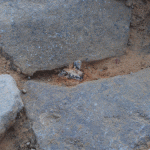
Three examples of the dried human coprolites found at the site. Image: Jim Barlow
Oregon’s Paisley Caves are as old as Clovis sites, but were inhabited by a different group.
Results from a new study of Oregon’s Paisley Caves indicate that humans were using the site as early as 12,450 radiocarbon years ago. But the projectile points left behind did not belong to the Clovis people, who inhabited North America at the time.
Instead, the projectiles appear to be related to the Western Stemmed tradition, according to associate professor Loren Davis from Oregon State University in the US. Unlike the Clovis technology, which has only been found in the Americas, artefacts from the Western Stemmed tradition have also been found in Asia.
“The Western Stemmed and Clovis traditions include different technological strategies,” Davis says. “The Western Stemmed artefacts from Paisley Caves are at least as old — and may predate — the oldest confirmed Clovis sites, indicating that the peopling of the Americas was at least technologically divergent, if not genetically divergent.”
The difference in technology revolves around how the projectiles were attached to spears — Clovis artefacts were made from large rocks and have a notch at the base, while the stemmed points have a restricted base and were made from smaller flakes. The groups used different chipping processes to produce the projectiles, according to lead author Dennis Jenkins from the University of Oregon.
“This really seems to suggest that there are multiple lines or technology trajectories at the same time period here at the end of the Pleistocene in the western hemisphere,” he says.
To determine when the artefacts were produced, the researchers turned to the human coprolites that had been discovered at the site. These ranged in age from 2,295 to 12,450 years ago and had not been contaminated by other humans or animals at later dates.
Fibres within the dried faeces were then tested for DNA. Even though the oldest coprolite was older than the projectiles, they belonged to the same genetic groups as the people using the site at the time the projectiles were made and used, according to Davis.
“The fact that Western Stemmed point-makers fully overlap, or even pre-date Clovis point makers likely means that Clovis peoples were not the sole founding population of the Americas,” he says.
The results of this study, which was published in Science this week, could have a serious impact on how we think the Americas were populated. The earliest models suggest that humans crossed from Asia to North America via a land bridge at the end of the Pleistocene and fanned out across the continent, but this doesn’t explain the presence of two different technologies.
“Given these recent results from Paisley Caves, it’s clear that we need to come up with some better models,” Davis says.






